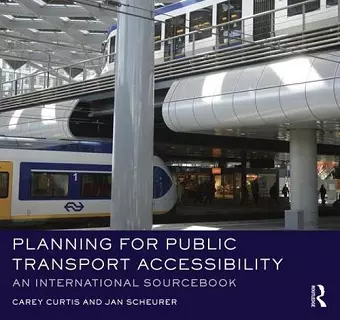Planning for Public Transport Accessibility
An International Sourcebook
Carey Curtis author Jan Scheurer author
Format:Hardback
Publisher:Taylor & Francis Ltd
Published:12th May '16
Currently unavailable, and unfortunately no date known when it will be back
This hardback is available in another edition too:
- Paperback£41.99(9780367668365)

Bringing together a comparative analysis of the accessibility by public transport of 23 cities spanning four continents, this book provides a "hands-on" introduction to the evolution, rationale and effectiveness of a new generation of accessibility planning tools that have emerged since the mid-2000s. The Spatial Network Analysis for Multimodal Urban Transport Systems (SNAMUTS) tool is used as a practical example to demonstrate how city planners can find answers as they seek to improve public transport accessibility. Uniquely among the new generation of accessibility tools, SNAMUTS has been designed for multi-city comparisons. A range of indicators are employed in each city including: the effectiveness of the public transport network; the relationship between the transport network and land use activity; who gets access within the city; and how resilient the city will be. The cities selected enable a comparison between cities by old world–new world; public transport modes; governance approach; urban development constraints. The book is arranged along six themes that address the different planning challenges cities confront. Richly illustrated with maps and diagrams, this volume acts as a comprehensive sourcebook of accessibility indicators and a snapshot of current policy making around the world in the realm of strategic planning for land use transport integration and the growth of public transport. It provides a deeper understanding of the complexity, opportunities and challenges of twenty-first-century accessibility planning.
"The final chapter of the book (Chapter 9) summarizes the overall findings and reflects upon answers to introductory questions such as “What structures and types of urban form can optimize accessibility?” or “How should we invest in public transport infrastructure?” (p. 3) leading to the conclusion that a “one size fits all-appoach” (p. 291) does not provide a realistic accessibility-optimizing perspective. This is also what I consider the top contribution of this book. [T]his book an important and well-needed pioneering contribution for accessibility planners worldwide."
Katrin Lättman, Journal of Transport Geography
Public transit is an essential component of a sustainable future, but how to design a system that meets accessibility needs given finite budgets? Curtis and Scheurer offer help in the form of a sophisticated yet practical tool for analyzing transit accessibility. They demonstrate its use with a fascinating comparison across four continents that yields insightful lessons for planners.
Susan Handy, University of California, Davis, USA
This is a unique and comprehensive sourcebook in the field of transport and urban planning. If you want to understand how cities and metropolitan areas around the globe are performing in terms of public transport accessibility, and what opportunities there are to improve it, read this book.
Karst Geurs, University of Twente, the Netherlands
ISBN: 9781472447241
Dimensions: unknown
Weight: 1224g
326 pages